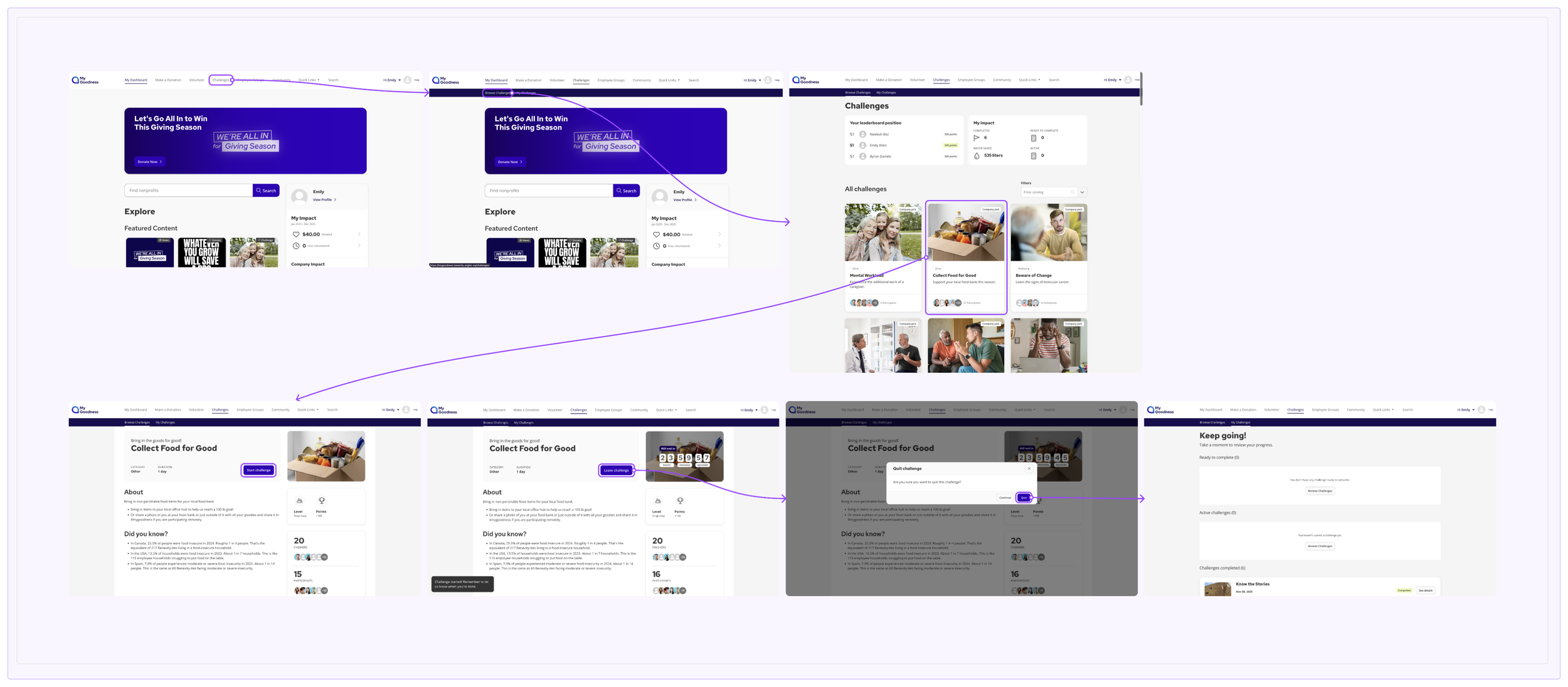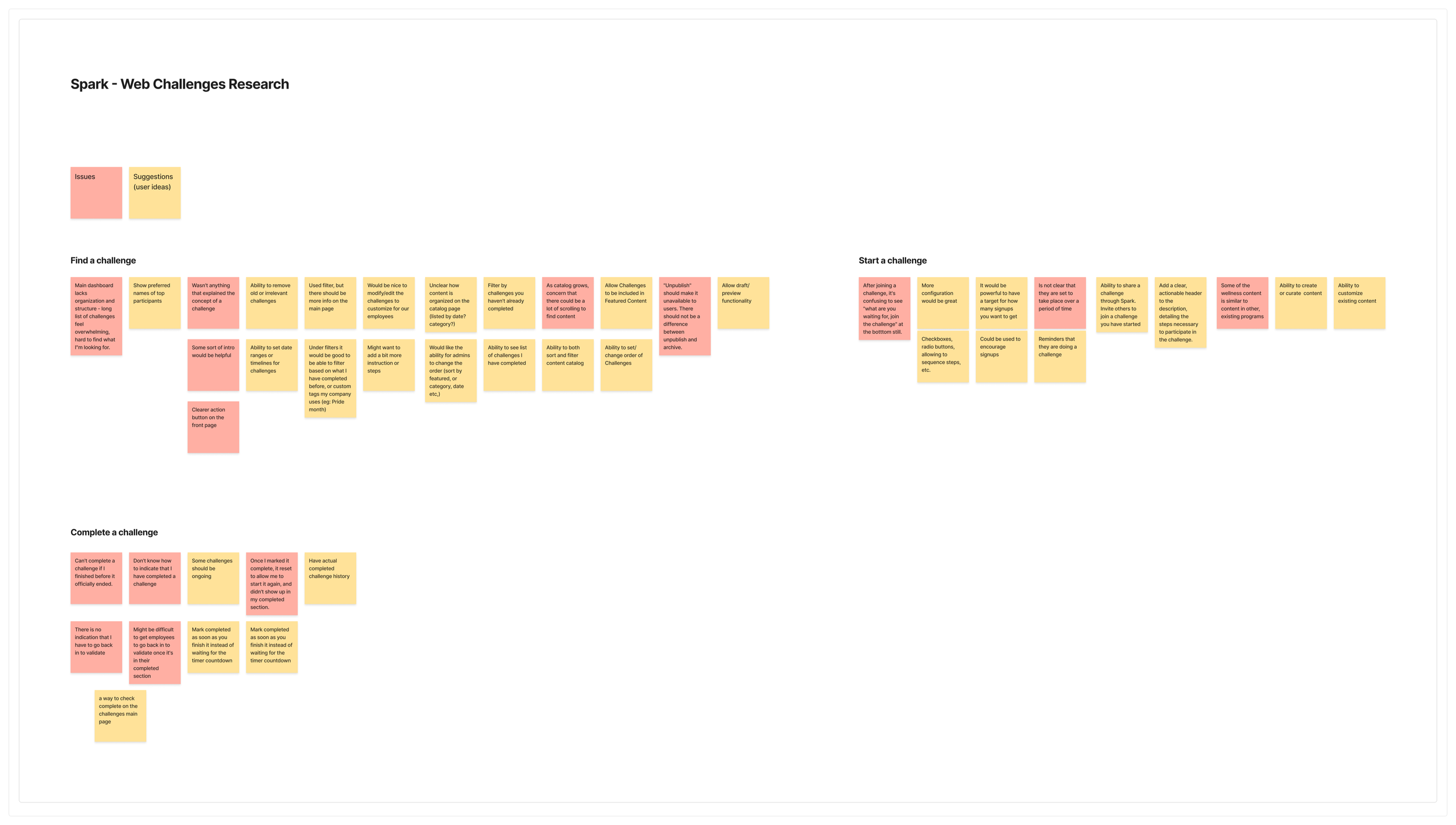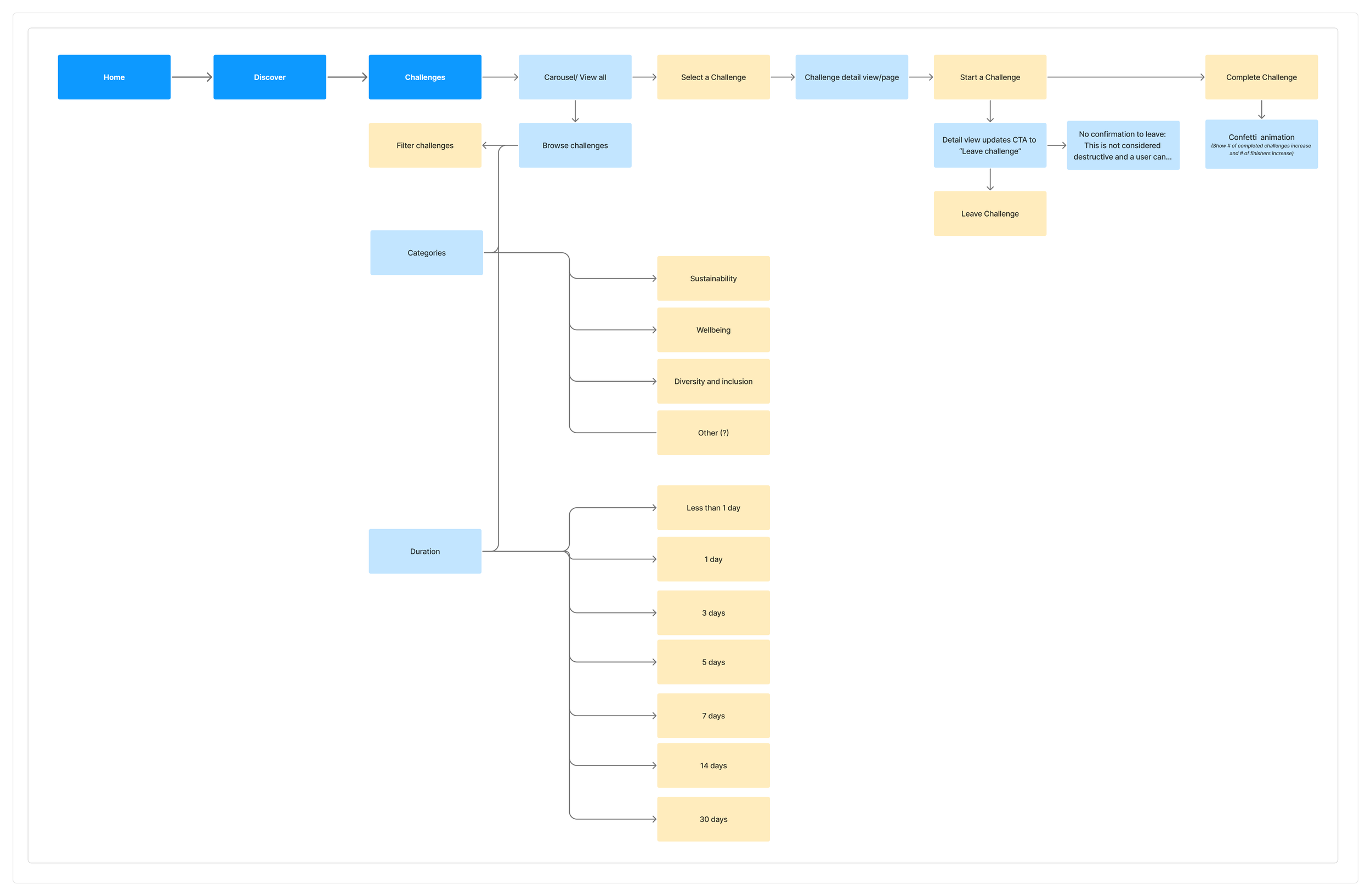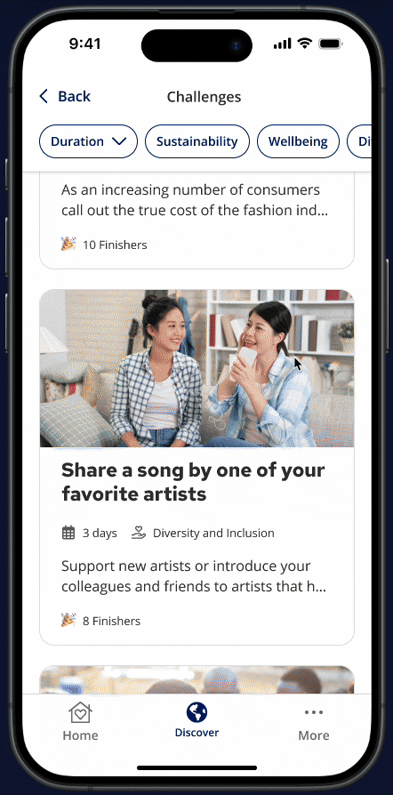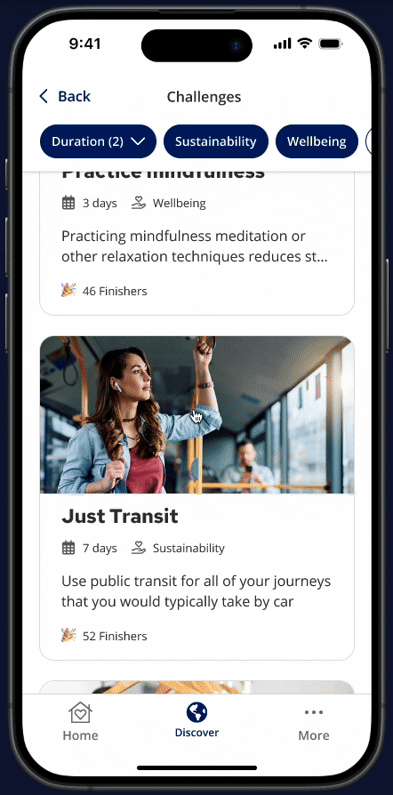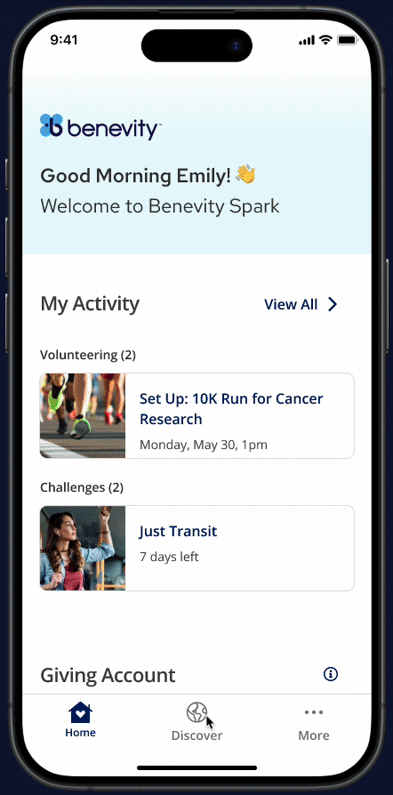Designing for Delight and Impact: How Small Interactions Sparked Big Engagement Gains
Designing mobile challenges from the ground up, leading end-to-end product design that drove a 40% lift in participation and turned everyday actions into meaningful impact.
As a result of my work, the team launched the first native mobile Challenges experience, expanding engagement beyond desktop and driving a 40% lift in participation. My end-to-end design process simplified complex web flows into quick, rewarding mobile interactions that made doing good effortless. The resulting MVP set a scalable foundation for future social and gamified features, while validating the role of mobile as a key engagement driver in Benevity’s ecosystem.
Impact
Product vision, end-to-end UX design, user research, interaction design, prototyping, usability testing, visual design, cross-functional collaboration
Role
Team
Product manager, iOS and Android engineers
Uncovering friction and finding opportunity
To ensure that existing research and data was taken into account, I analyzed the existing web Challenges experience to identify usability pain points and behavioral gaps that could derail a mobile experience.
I uncovered that users were struggling with:
Web flows were time-consuming and text-heavy, not suited for on-the-go users
Users wanted fewer steps and instant confirmation upon completing actions
Layouts didn’t scale gracefully across different screen resolutions
These insights revealed a clear opportunity to combine simplicity, social engagement, and rewarding feedback loops to drive repeat participation and delight.
Implement a simple, easily accessible filtering interaction using familiar native mobile components and patterns.
Display prominent visual badges on each challenge card. Maintain an accessible history or activity for ongoing and completed challenges.
What did this mean for the mobile experience?
Before mapping the flow, I conducted external research into native mobile interaction patterns to ensure that key elements of the Challenges experience translated intuitively from web to mobile. I explored filtering menus, floating action buttons, and bottom sheets to determine how users naturally navigate and interact within native environments.
Through this analysis, I identified that bottom sheets were the most familiar and efficient pattern for selecting and applying filters, providing a smooth, focused experience without disorienting users from their current view. Additionally, I introduced quick-access filters in a carousel at the top of the screen, enabling users to toggle categories on and off with minimal friction — ideal for quick, on-the-go browsing.
Use push notifications to provide timely, encouraging nudges to prevent users from forgetting they are participating in a challenge.
Ability to track remaining days and leave a challenge at any time.
Defining the core mobile journey
With these patterns in mind, I mapped the end-to-end journey for the mobile challenges experience.
Discover challenges (browse or filter by category/ duration)
View details and start a challenge, stay up-to-date with push notifications directly to your device
Complete a challenge and receive celebratory feedback instantly
Designing for clarity, motivation and reward
My design strategy focused on creating an experience that felt as rewarding as it was effortless. Every element - motion, colour, micro interaction, was designed to reinforce accomplishment and motivation.
Core principles:
Fast participation: Find and start a challenge in under a minute
Positive reinforcement: Animations and progress indicators created an instant dopamine feedback loop
Platform-native usability: Leveraged native iOS and Android patterns for familiarity and global user scalability
Testing, iterating and elevating the experience
I led multiple rounds of usability testing with internal users and external participants. Rather than testing for aesthetic preference, I focused on comprehension, flow clarity, and motivation.
Trying on different components, placements and interactions
Refinements based on testing findings:
Streamlined the completion flow to minimize the number of taps required, allowing users to finish a challenge faster and with less friction
Refined confirmation and feedback messaging to clearly communicate task completion and next steps, reducing user hesitation and uncertainty
Simplified filter patterns for smaller screen resolutions, ensuring responsive adaptability
Discover challenges
Find your next good deed in seconds! Scroll through a variety of high-impact opportunities on the Discover tab and tap into the dedicated Challenges area.
The goal was to make Challenges a primary entry point for mobile engagement, elevating it from a secondary section on the web. We integrated a dedicated Challenges carousel directly onto the "Discover" tab, a highly frequented area. This placement leveraged existing user habits for exploring opportunity to partake in acts of goodness, as well as high visibility to drive initial feature adoption.
Focus:
Visibility , speed, and variety
Each challenge card was designed to be scannable. It features a compelling image, clear title, and critical social cues (finisher count) immediately, allowing users to assess relevance and popularity without leaving the page.
Filtering to find relevant challenges
The filter design uses a set of horizontal, scrollable chips (like Duration, Sustainability, Wellbeing, and Diversity and Inclusion) at the top. This pattern is inherently thumb-friendly and allows for rapid, one-tap filtering without forcing the user into a complex modal or form.
This replaced the dropdown menus or sidebars common on the web, making the experience feel instant , modern and natively mobile. Users can quickly change between different cause categories.
Focus:
Mobile-first user experience , and relevance
By allowing users to quickly filter by criteria like Duration, we directly addressed the pain point of time commitment. Users could find a "3-day" challenge, ensuring engagement could fit into their real-world schedule.
This feature directly supports the core mobile objective: enabling participation in micro-moments by quickly surfacing manageable commitments.
Starting a challenge
Before committing, the challenge detail screen provides a clear "About" section, estimated duration, and social activity. The "Start Challenge" button is highly visible and located in the accessible thumb zone at the bottom.
The flow from browsing to starting is seamless and fast. Once tapped, the challenge immediately transitions to the "Started" state, giving instant feedback that the action was successful.
This immediate response aligns with native app expectations, reinforcing the feeling of speed and responsiveness essential for mobile engagement.
Focus:
The focus here was on transparency. Ensuring the user understood the action and commitment before starting reduced abandonment rates and frustration later on.
Leaving a challenge
The "Leave" option is clearly presented on the challenge detail page, empowering the user to manage their commitments. It’s secondary to the "View My Activity" (or completion) button to prevent accidental taps, but easy to find.
The design includes a lightweight confirmation to prevent accidental exits, ensuring the user is certain without interrupting the flow excessively.
Focus:
Offering a clear exit strategy respects the user’s time and reduces platform fatigue. It signals that the platform values user choice over forced participation.
Validating a challenge
This step is the heart of the gamification loop. Tapping the challenge on the home screen immediately opens the validation flow. Once completed, the design triggers a full-screen, celebratory animation (confetti).
The celebratory animation is a feature that only exists on the mobile app, it was designed to create a powerful dopamine feedback loop, directly solving the original pain point of "low sense of reward." The recognition is immediate and sensory.
Focus:
The ability to log progress directly from the Home screen's "My Activity" section is key. The user doesn't have to navigate deep into the app to log their action.
Providing the validation link right on the Home screen ensures logging impact is as simple and quick as possible, critical for maximizing the conversion from challenge in progress to completed challenge.
Turning Insights into impact
Prioritizing simplicity, speed, and instant gratification - resulted in a significant shift in mobile user behaviour and platform engagement:
Achieving Engagement and Reward
First-Time Mobile Engagement: The Challenges feature successfully unlocked the mobile platform, enabling users to participate in acts of goodness on-the-go for the very first time.
Positive Feedback Validation: Qualitative feedback was overwhelmingly positive, emphasizing speed, clarity, and an immediate sense of reward. The celebrated animation loop successfully created the intended dopamine-driven cycle that motivated continuous, low-friction participation.
Setting the Foundation for Scalable Growth
Future-Proofing Gamification: The design established a scalable, native foundation ready for advanced social features. By demonstrating the success of basic gamification mechanics (points, instant feedback), we paved the way for the subsequent full integration of key web features, including the Leaderboard and Team Progress tracking, maximizing social competition and community connection.
Driving Platform Value: The feature proved that quick, rewarding actions could drive repeat visits and increase overall platform usage, validating mobile as a primary growth channel for Benevity’s impact programs.
Reflection: designing for momentum and meaning
This project was a defining moment in my career, a full circle opportunity to take ownership, translate a proven concept into a new medium, and design an experience that inspires everyday impact.
Key takeaways
Scoped and delivered a net-new feature within tight MVP timelines
Balanced user motivation with technical constraints
Strengthened full product design ownership - from concept to delivery
Created a design foundation that continues to evolve with new features


